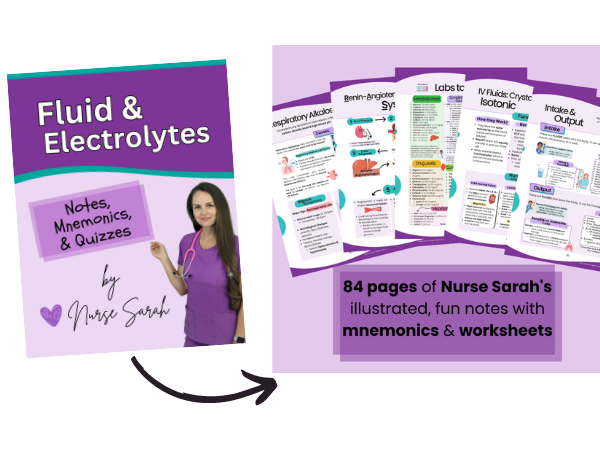Are you studying hypernatremia and need to know some mnemonics on how to remember the causes, signs & symptoms, nursing interventions? This article will give you some clever mnemonics on how to remember hypernatremia for nursing lecture exams and NCLEX.
In addition, you will learn how to differentiate hypernatremia from hyponatremia. Don’t forget to take the hypernatremia & hyponatremia quiz.
In this article you will learn:
- Normal Sodium Level
- Causes of Hypernatremia
- Signs & Symptoms of Hypernatremia
- Nursing Interventions for Hypernatremia
Teaching Tutorial on Hypernatremia
Nurse Sarah’s Notes and Merch

Just released is “Fluid and Electrolytes Notes, Mnemonics, and Quizzes by Nurse Sarah“. These notes contain 84 pages of Nurse Sarah’s illustrated, fun notes with mnemonics, worksheets, and 130 test questions with rationales.
You can get an eBook version here or a physical copy of the book here.
Hypernatremia
Hyper: “excessive”
Natr: Prefix for Sodium
Emia: blood
Meaning of Hypernatremia: excessive sodium in the blood isotonic, hypotonic, and hypertonic tonicity.
Normal sodium levels: 135 to 145 mEq/L (>145 sodium is hypernatremic)
Role of sodium in the body: It’s an important electrolyte that helps regulate the amount of water inside and outside of the cell (water and sodium loves each other).
Where ever sodium goes, so does water. Watch my video on hypotonic, hypertonic, and isotonic tonicity.
For example, in hypernatremia there is a lot of sodium outside the cell and this attracts the water from inside the cell which will cause water to move outside the cell and dehydrate the cell. Sodium also plays a role in muscle, nerves, and organ function.
Causes of Hypernatremia
Remember the phrase “HIGH SALT”
Hypercortisolism (Cushing’s Syndrome), hyperventilation
Increased intake of sodium (oral or IV route)
GI feeding (tube) without adequate water supplements
Hypertonic solutions
Sodium excretion decreased (body keeping too much sodium) and corticosteroids
Aldosterone overproduction (Hyperaldosteronism…Conn’s Syndrome)
Loss of fluids (dehydrated) infection (fever), sweating, diarrhea, and diabetes insipidus
Thirst impairment
Signs & Symptoms of Hypernatremia
Remember: “No FRIED foods for you!” (too much salt)
Fatigue
Restless, really agitated (confused….central nervous system changes)
Increased reflexes (progress to seizures and coma)
Extreme thirst (*big sign)
Decreased urine output, dry mouth/skin
Nursing Interventions for Hypernatremia
- Restrict sodium intake! Know foods high in salt such as bacon, butter, canned food, cheese, hot dogs, lunch meat, processed food, and table salt.
- Keep patient safe because they will be confused and agitated.
- Doctor may order to give isotonic or hypotonic solutions such as 0.45% NS (which is hypotonic and most commonly used). Give hypotonic fluids slowly because brain tissue is at risk due to the shifting of fluids back into the cell (remember the cell is dehydrated with hypernatremia) and the patient is at risk for cerebral edema. In other words, the cell can lyse if fluids are administered too quickly.
- Educate patient and family about sign and symptoms of high sodium level and proper foods to eat.